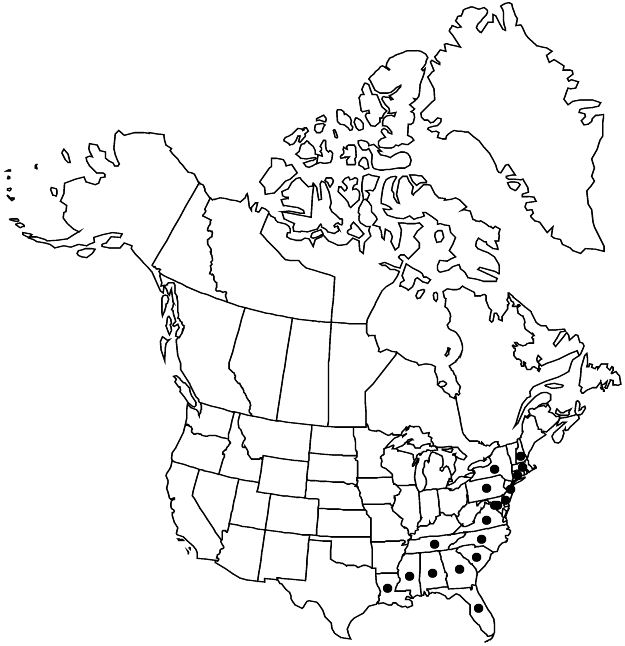Rubus cuneifolius
Fl. Amer. Sept. 1: 347. 1813.
Shrubs, 5–10 (–30) dm, armed. Stems biennial, erect, rarely arching, sparsely to densely hairy (especially young), eglandular, not pruinose; bark not papery, peeling; prickles usually dense, hooked to retrorse, usually stout, 3–6 mm, broad-based. Leaves deciduous to semievergreen, usually ternate, sometimes palmately compound; stipules filiform or linear to lanceolate, 3–15 mm; leaflets 3–5, terminal cuneate to obovate, 2–6 × 3–4 cm, base cuneate, unlobed, margins serrate, rarely doubly serrate, apex broadly rounded to subtruncate, often cuspidate, abaxial surfaces often with prickles on midveins, densely gray to white-hairy, sparsely to densely sessile-glandular. Inflorescences terminal on short-shoots, sometimes appearing axillary, (1–) 3–5 (–12) -flowered, cymiform. Pedicels unarmed or prickles sparse to moderate, hooked to retrorse, moderately to densely hairy, eglandular or sparsely to moderately sessile-glandular. Flowers bisexual; petals white, elliptic to obovate, 5–15 mm; filaments filiform; ovaries glabrous or glabrate. Fruits black, globose to cylindric, 0.6–2 cm; drupelets 15–50, strongly coherent, separating with torus attached. 2n = 21, 28.
Phenology: Flowering May–Jul.
Habitat: Dry to damp open areas, sandy or rocky soil
Elevation: 0–300 m
Distribution

Ala., Conn., Del., D.C., Fla., Ga., La., Md., Mass., Miss., N.H., N.J., N.Y., N.C., Pa., S.C., Tenn., Va.
Discussion
Rubus cuneifolius is characteristic of the Coastal Plain and Piedmont. The species is distinguished from most other blackberries in the flora area by its usually strongly erect and shrub-forming habit and abaxial leaflet surfaces often with dense white to gray indument; it may be confused with R. pascuus. Rubus cuneifolius has white petals and cuneate to obovate leaflets with usually revolute margins, the proximal third entire; R. pascuus has pale pink to white petals and ovate to broadly elliptic leaflets with the margins flat and entire only at base.
Rubus longii Fernald may represent hybridization between R. cuneifolius and another, yet-undetermined, blackberry (perhaps R. pascuus). Hybrids of R. cuneifolius and R. hispidus can be found around abandoned commercial cranberry bogs in New Jersey (G. Moore, pers. obs.). Rubus cuneifolius is introduced in South Africa and is officially recognized there as a noxious weed (L. Henderson 1995; T. Olkers and M. P. Hill 1999; H. Klein 2002). Preliminary examination of plants identified as R. cuneifolius from South Africa has shown that the plants are not R. cuneifolius but may be hybrids involving R. cuneifolius and another species.
The following nothospecies names are based on putative hybrids involving Rubus cuneifolius and: R. pensilvanicus (R. ×acer L. H. Bailey, R. ×acer var. subacer L. H. Bailey, R. ×argutinus L. H. Bailey, R. ×floridensis L. H. Bailey); R. trivialis (R. ×inferior L. H. Bailey).
Selected References
None.
Lower Taxa
"thin" is not a number."dm" is not declared as a valid unit of measurement for this property.